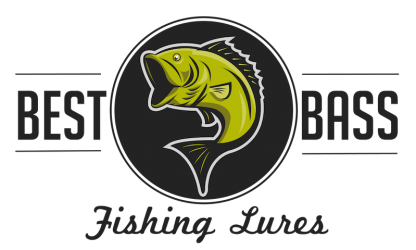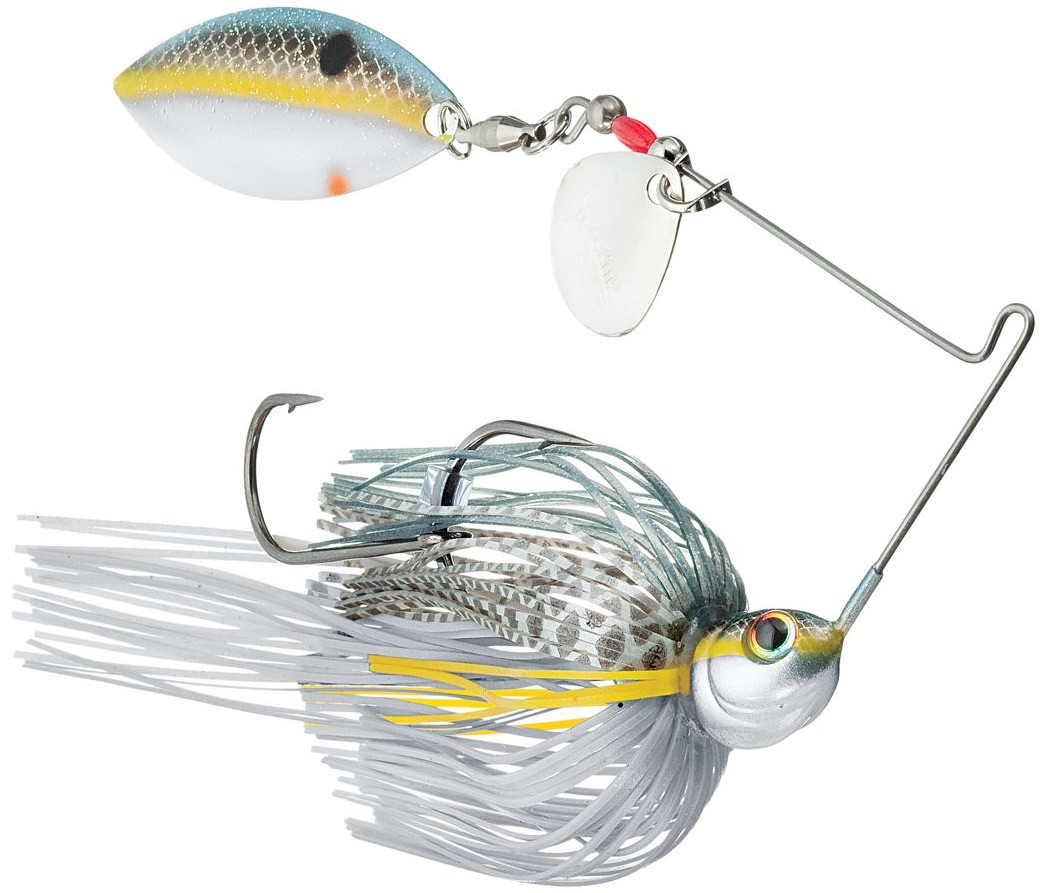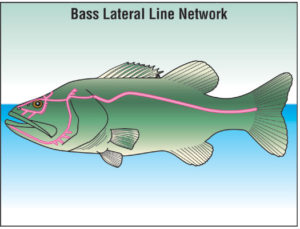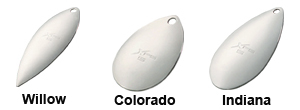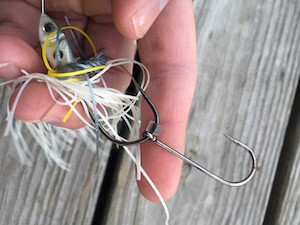At first glance, a spinnerbait doesn’t appear like it would be an effective lure because there’s really nothing natural looking about them. But that couldn’t be further from the truth. Spinnerbaits have been one of the best bass lures for decades, using flash and vibration to trigger the attention of bass.
Simply put, a spinnerbait is a wire that is bent at a ninety degree angle with a jig head on one end and a blade on the other. The jig head is typically dressed with a rubber skirt. The blade end will have a swivel connecting the blade to the wire and allowing the blade to flutter and spin freely. The fishing line ties at the bend.
Fishing a spinnerbait can be as easy as casting it out and reeling it straight in. That’s the beauty of a spinnerbait, they produce their own action. Of course there’s more to it if you want to become an expert in all conditions with these lures.
This page is all about spinnerbaits, including how to select them and how to fish them. But if your simply looking for the best spinnerbaits then check out our top three below.
Contents
Selecting A Spinnerbait
The two most important factors you need to consider when selecting a spinnerbait is the retrieve speed and depth you’re looking to achieve. These two factors are heavily based on the style of spinnerbait blade you choose. Not only the style but the number of blades as well. Most spinnerbaits today have multiple blades on them.
Naturally, the weight of the spinnerbait is going to have an effect on the running depth as well. The heavier the weighted head of the bait is the faster it is going to sink down in the water column. Spinnerbaits come in a variety of different weights, but the most popular weight for a spinnerbait is in the three-eighths to half an ounce range.
The blades on spinnerbaits put out a ton of vibrations in the water, and these vibrations are easily detected by bass through their unique sensing ability. Bass have a line of modified scales that are sensitive to vibrations in the water known as the lateral line. And it’s so sensitive that bass are able to sense vibrations from several dozen yards away.
The lateral line starts just behind eye of a bass and goes all the way to the tail on both sides of their bodies. Not only does it transmit the vibrations to the brain, it also measures distance and direction.
Not only are the various blades of a spinnerbait putting out different vibrations, but they are also controlling the speed and running depth of the bait. The size and style of the blade is going to determine how much water it displaces.
The more water displacement there is, the slower it is going to move through the water. As well as keep it higher up in the water column. Same is true for increasing the amount of blades on the spinnerbait. So to be truly effective spinnerbait fishing, you are going to need more than one style blade in your spinnerbait box.
Types of Spinnerbait Blades
There are three styles of spinnerbait blades: the Willow blade, the Colorado blade, and the Indiana blade. They all work the same way by spinning to create flash and vibration in the water.
What makes one style blade different from the next is the shape. This is what regulates how much vibration they create and how fast or slow they travel through the water.
Each style has their own strengths and weaknesses that either make them better or worse in certain conditions. Here’s a breakdown of each one and when you should use them.
Willow Blade
The Willow blade is long and skinny, designed to cut through the water much faster than any of the other blade styles. This is good choice for a blade when bass are active and chasing fast moving baits.
The skinnier blade also makes them the best spinnerbait blade for targeting deeper water because they dive down in the water column faster. They can even continue to sink as they are retrieved.
Willow blades spin the fastest so the vibration is tighter but not as powerful as other blade styles. Since they don’t thump as loud as other blades bass won’t be able to detect them as easily from a long distance with their lateral line.
That’s why they are best used in clear water, where bass are mainly relying on their sight to detect prey. But that said, you don’t want a bass to get a good look at a spinnerbait because of how unnatural they appear. All you want them to see is flash and movement. That’s what makes these fast moving blades ideal for clear water conditions.
Colorado Blade
The slowest moving spinnerbait blade is the Colorado blade. These blades have more of a rounded shape that causes them to displace more water as they spin, while slowing the bait down big time.
They also give the bait some lift, keeping it up in the water column as it’s retrieved. These blades are ideal for fishing shallow water or when you want to run the bait just below the surface.
Colorado blades spin slowest and put out more of a thumping vibration. They are the best choice when you need to use sound to attract bass.
That’s why these blades work so well in murky water where visibility is low. Bass will be relying more on their lateral lines than their eyes for find prey. It’s hard to beat a spinnerbait with a Colorado blade when fishing in shallow, murky water.
Indiana Blade
The Indiana blade falls somewhere in between the Colorado blade and the Willow blade. It takes the attributes from both blades and combines them in to a single blade, creating more of an oval shape.
This is a good blade when your fishing different water depths and still zeroing in on where the bass are holding. It’s also perfect for when you’re looking for a more moderate speed, like when water is not completely clear or murky.
Blade Combinations
Combining blades can help you zero in on the exact depth your targeting and action your looking to put out. You may have heard anglers refer to a tandem spinnerbait, which means it has a main blade combined with a secondary blade.
Some spinnerbaits are even designed to have three or more blades. The purpose of these multi-blade designs is to create more vibration and flash, while combining the advantages of the different style blades in to one spinnerbait.
Trailer Hooks
It’s never a bad idea to implement the use of trailer hooks on your spinnerbaits. Bass often come up short when attempting to bite these fast moving lures, which you will begin to see once you catch a few bass on your trailer hook.
A trailer hook is simply an additional hook attached to the back end of the lure. The eyelet of the trailer hook slides over the main hook and trails behind the lure as its retrieved. A little plastic stopper needs to be added to keep the trailer hook from slipping off.
Fishing Spinnerbaits
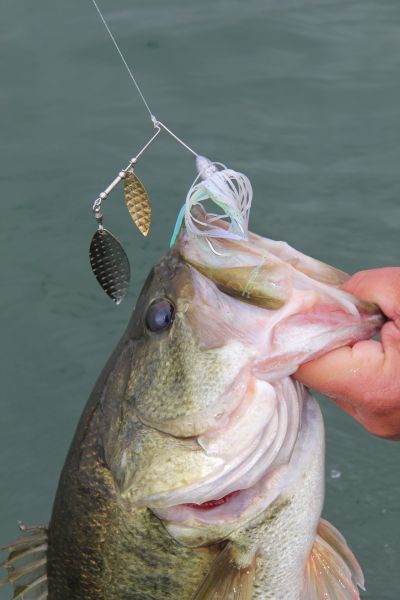
Since spinnerbaits create their own action, the most common way to fish them is by simply casting them out and reeling them back in a straight retrieve. Fishing them this way will certainly catch fish, but it’s knowing where and when to use a spinnerbait that makes the difference.
Spinnerbaits work exceptionally well on overcast days when there is some wind and ripple on the surface. You should always be trying to cast them at targets like along docks, rocks, and weed edges.
To increase and decrease the speed of retrieval, aside from adjusting reel speed and blade style, you can bend the wire frame wider or narrower than the original ninety degrees. Bending it open to a wider angle will slow the bait down and narrower will increase the speed.
The wire has a secondary benefit of functioning as a weed guard, making the lure somewhat weedless. Your not going to be able to get these baits through thick cover, but spinnerbaits work exceptionally well in light cover like through grass and timber.
Being able to cast and reel spinnerbaits in a straight retrieve effectively, make them great for covering a lot of water and trying to locate fish. But there are a few other ways to entice bites than with a simple straight retrieve.
Spinnerbait Techniques
The repetitive motion of a spinnerbait in a straight retrieve can be unappealing to bass when they’re inactive, seeing too many spinnerbaits, or when the conditions simply don’t call for it. That’s when different techniques should be implemented that better fit the conditions. Here are some very effective methods for fishing spinnerbaits.
Reaction Bites
A great way of triggering strikes when a straight retrieve isn’t doing the trick, is to every so often as you’re reeling give your rod a jerk to make the bait change up it’s repetitive action. The best time to jerk the rod is right when the lure is passing by some sort of cover like a rock or log. A lot of times this can be the difference between a bass instantly attacking it or slowly investigating it.
Jerking the rod like this creates what is called a reaction bite. This is when a bass reacts to the sudden random movement of a lure by attacking it. If an inactive bass sees a spinnerbait rolling by at a consistent pace, they know they have time to follow and investigate it. By randomly jerking the rod tip your making the bait’s behavior seem more unpredictable, making a curious bass more likely to attack it.
Sub-Surface
Running a spinnerbait just under the surface so that the blade disturbs the surface is a very effective tactic. You’ll have to keep the rod tip up high as you reel to keep the bait up close to the surface. Using a Colorado blade will also help keep the bait up.
This technique is almost like fishing a topwater lure. It works best in warm shallow water, like in late spring or summer. But you can get good results in deeper water too, especially if you see baitfish swirling on the surface and run the spinnerbait right through them.
YoYo Method
This is a great tactic when bass are inactive and not chasing fast retrieves. It’s called the yoyo retrieve because you make the lure go up and down like a yoyo.
Basically you let the spinnerbait sink to the bottom right off the cast. Then you lift the rod tip up and lower it while reeling in the slack. This will make the bait jump up and down off the bottom, spinning the blade as it rises and letting it flutter as it sinks. This is an excellent method for fishing a spinnerbait in cold water.
